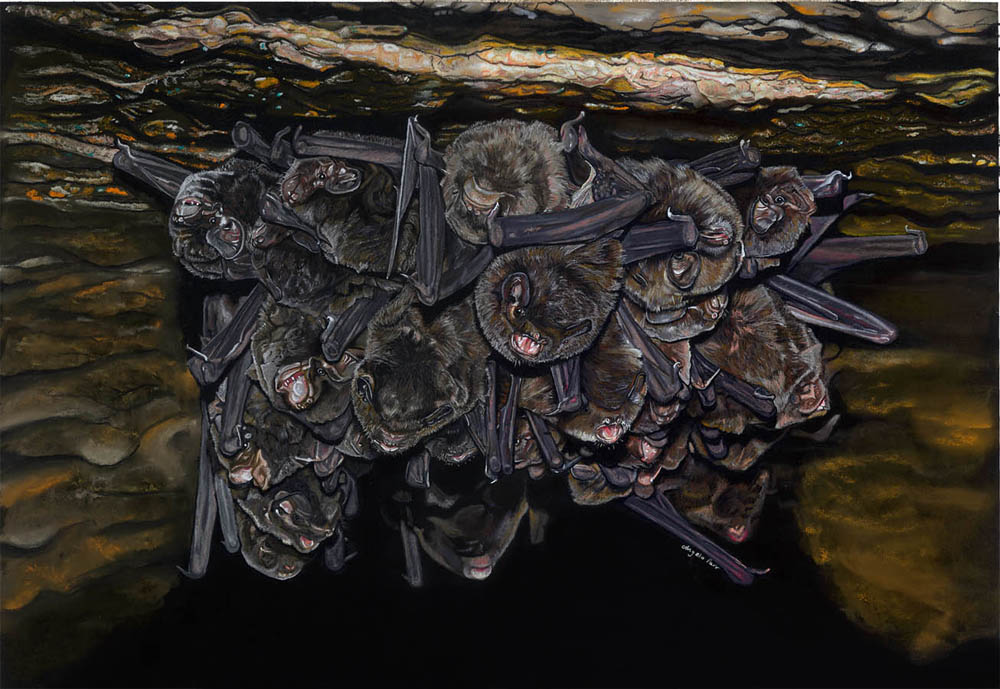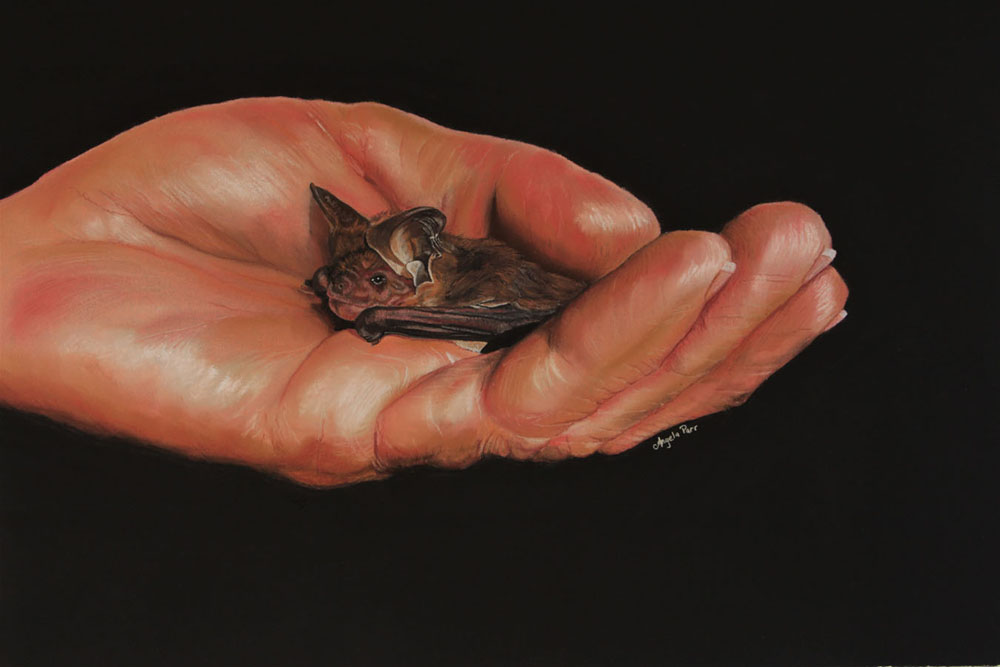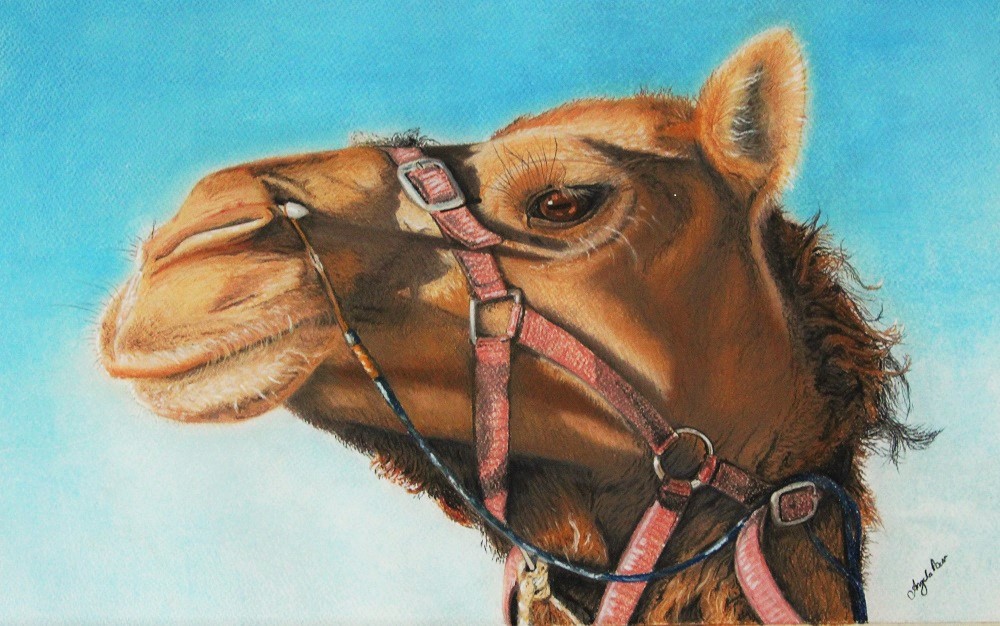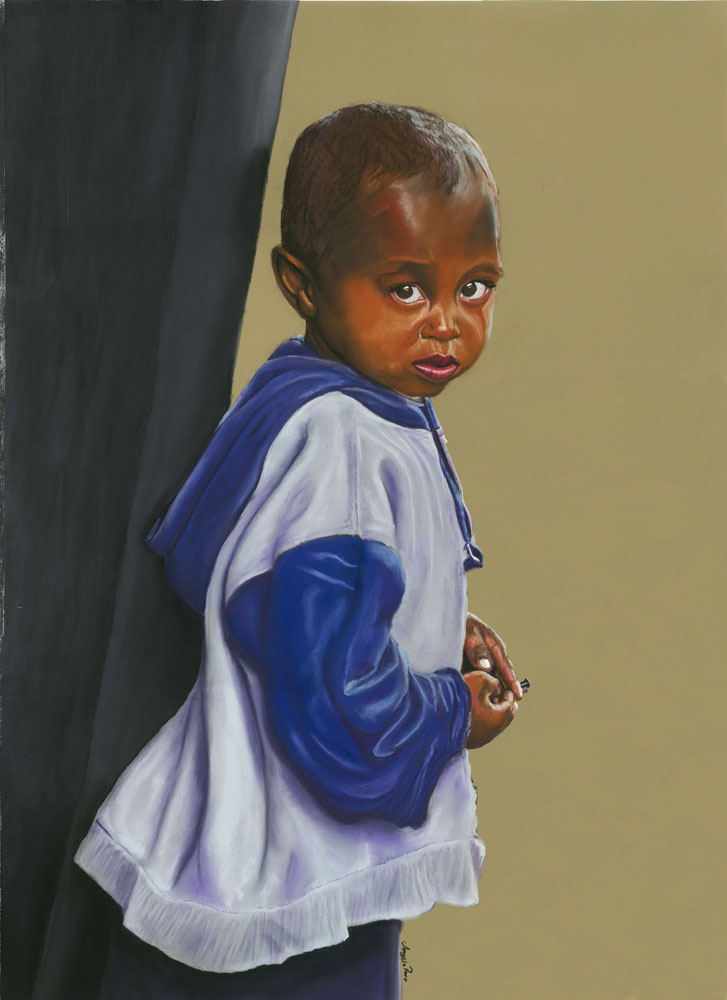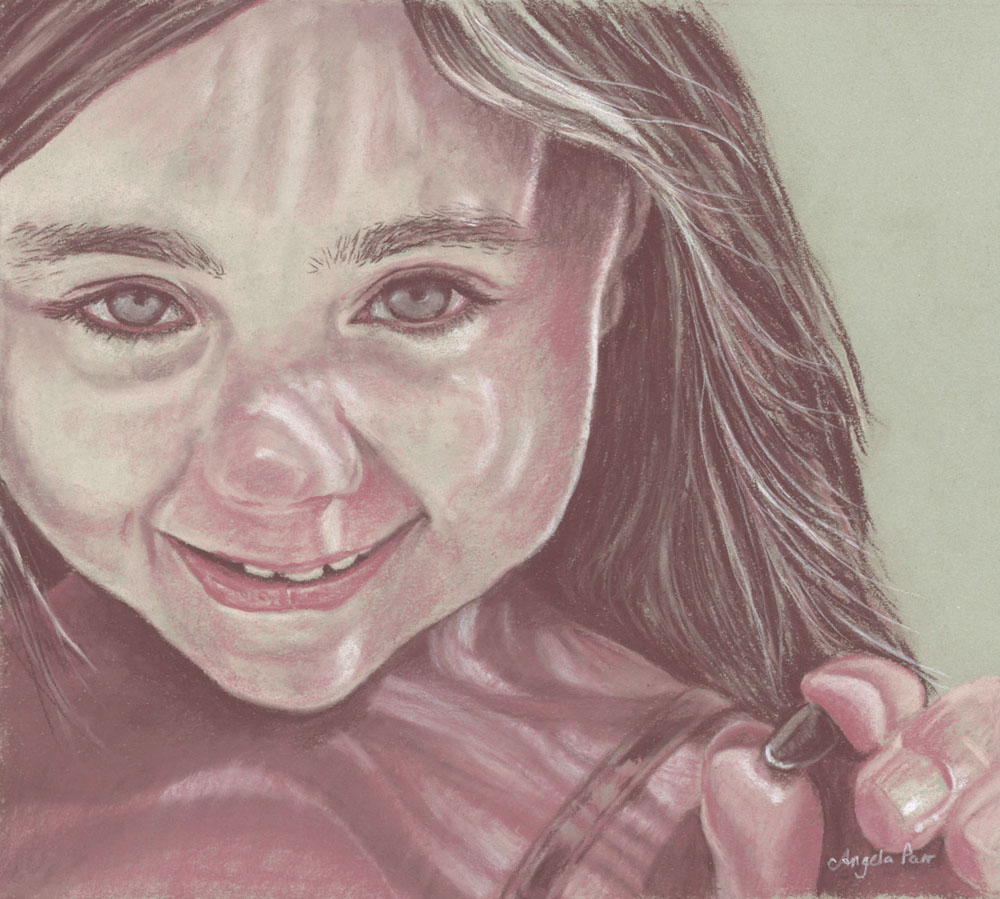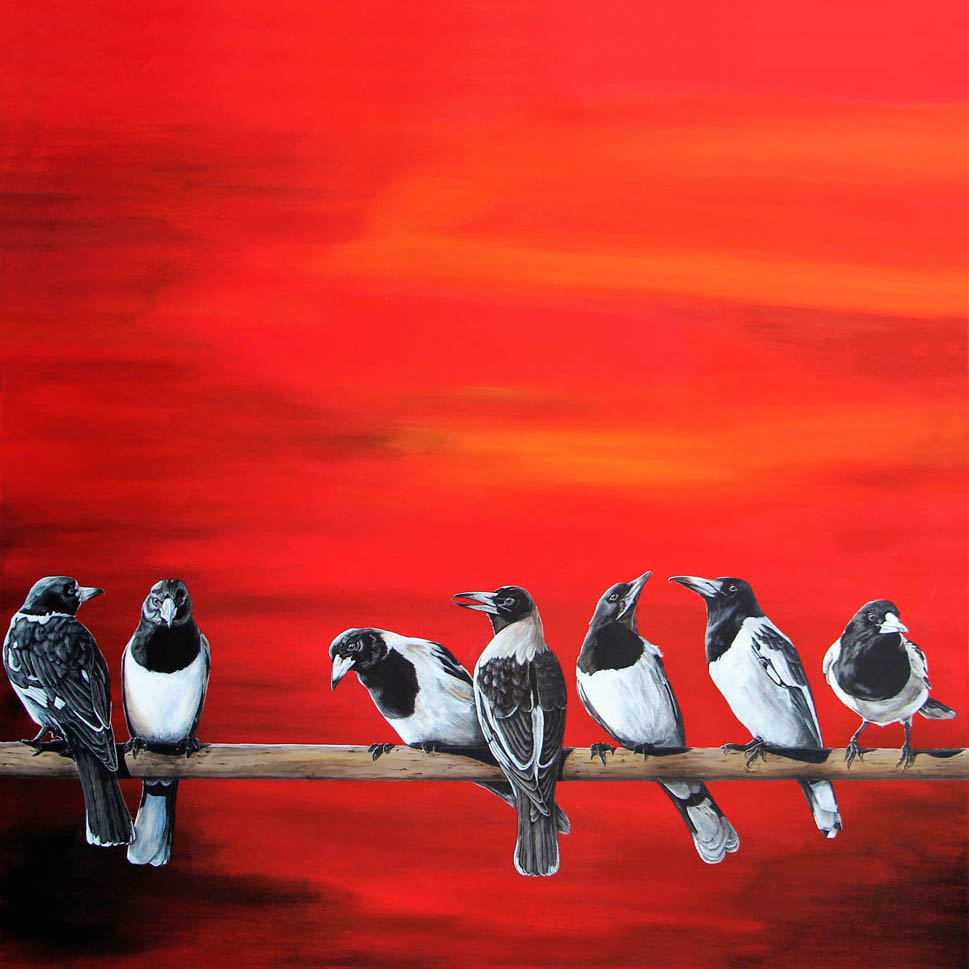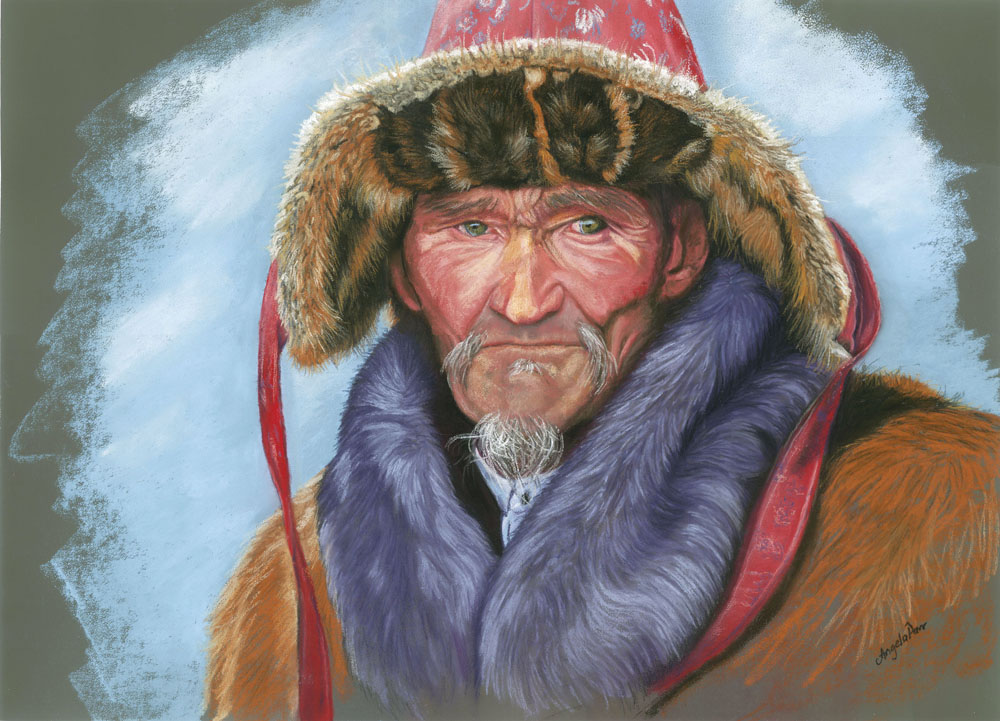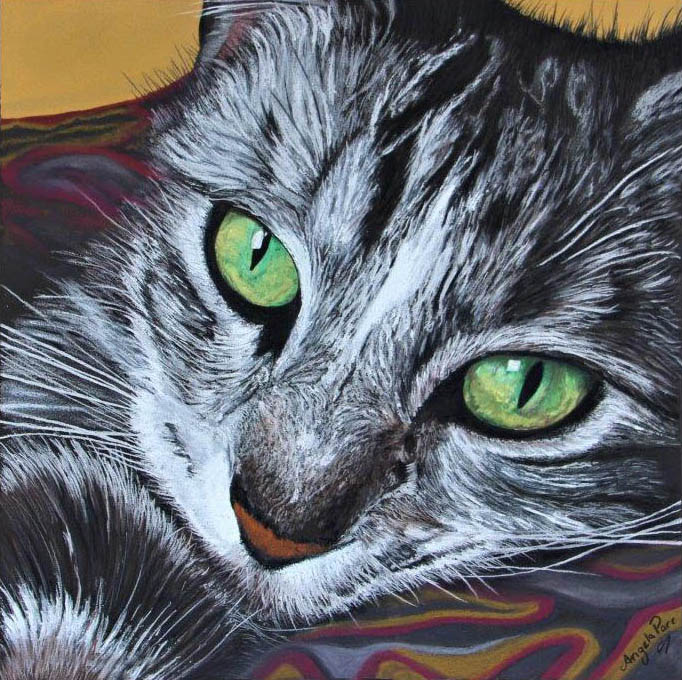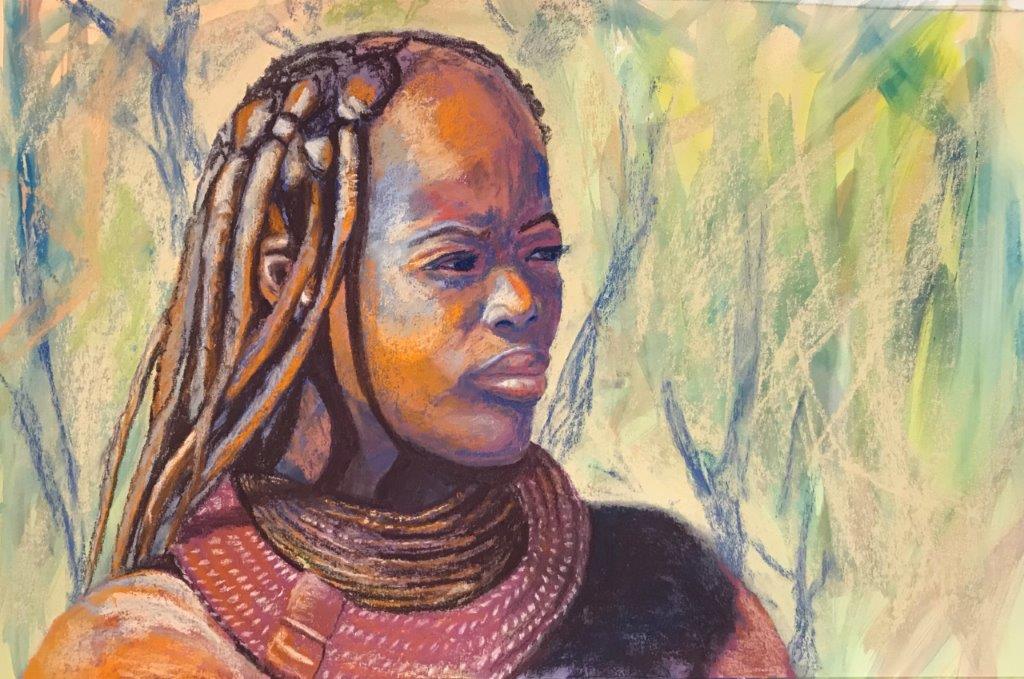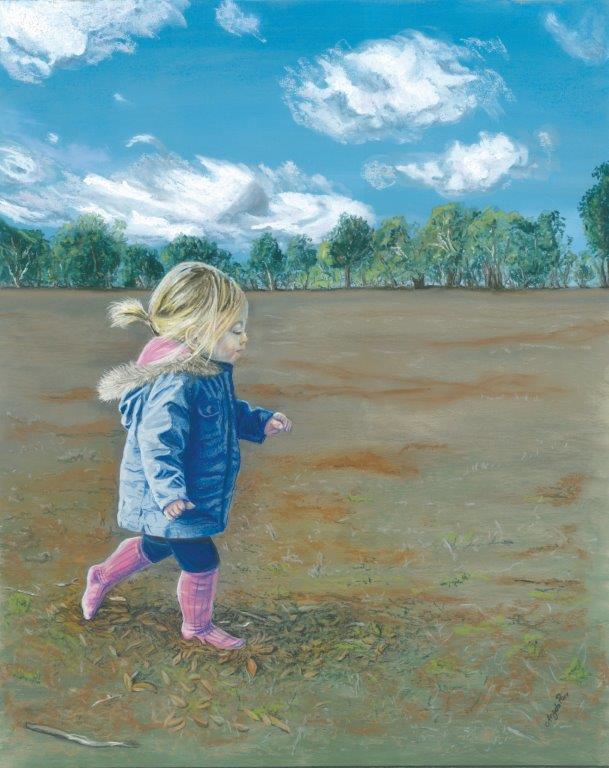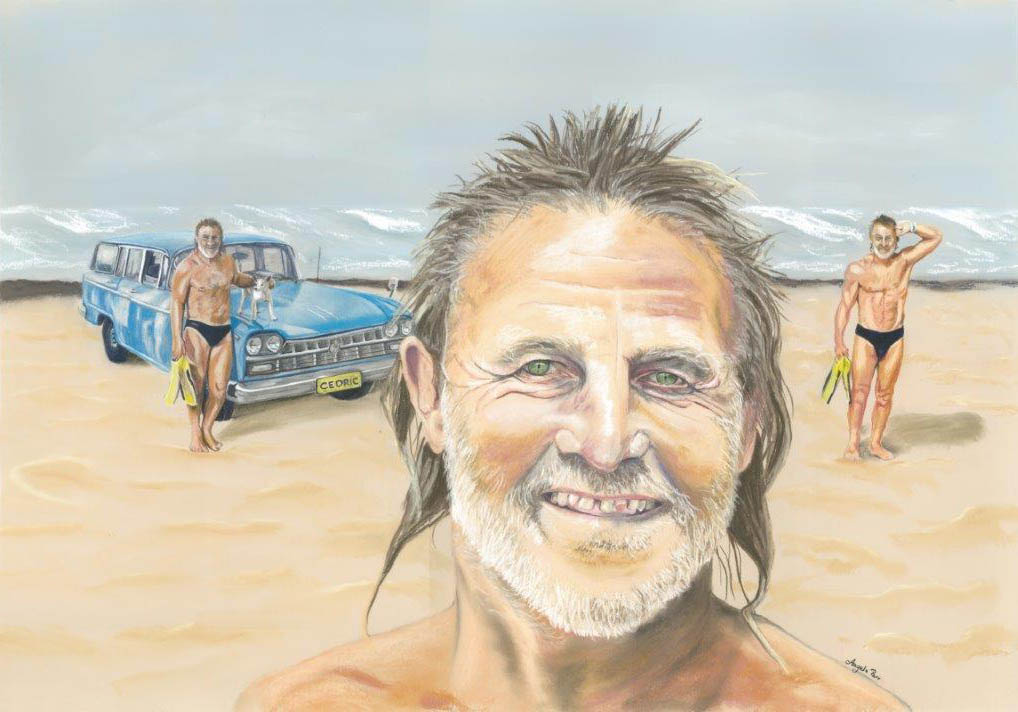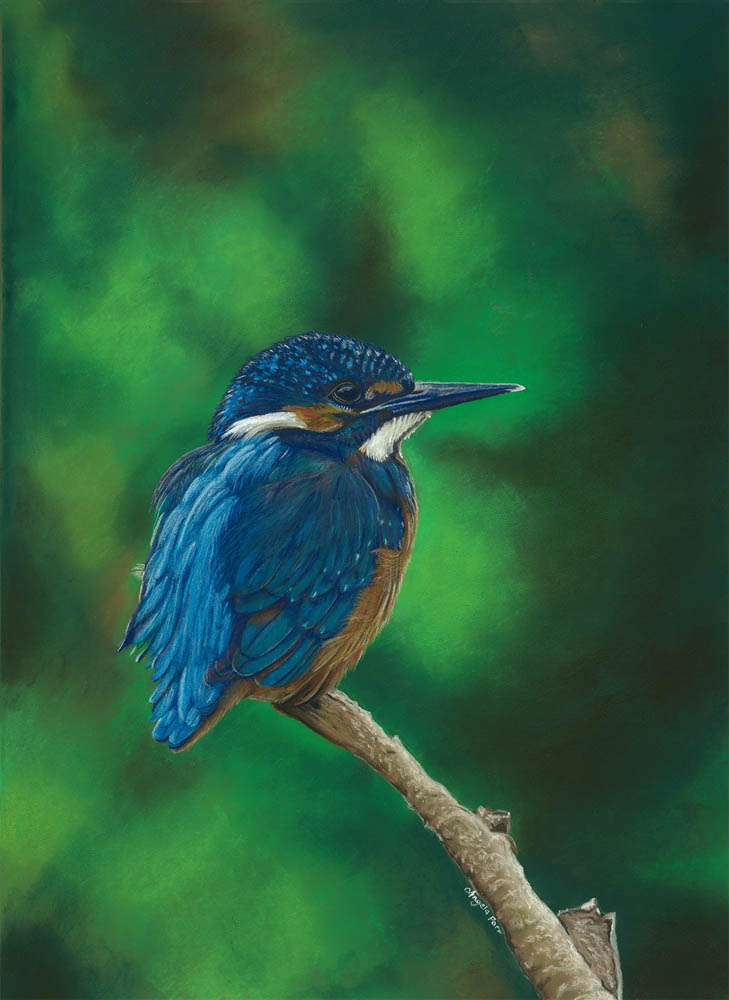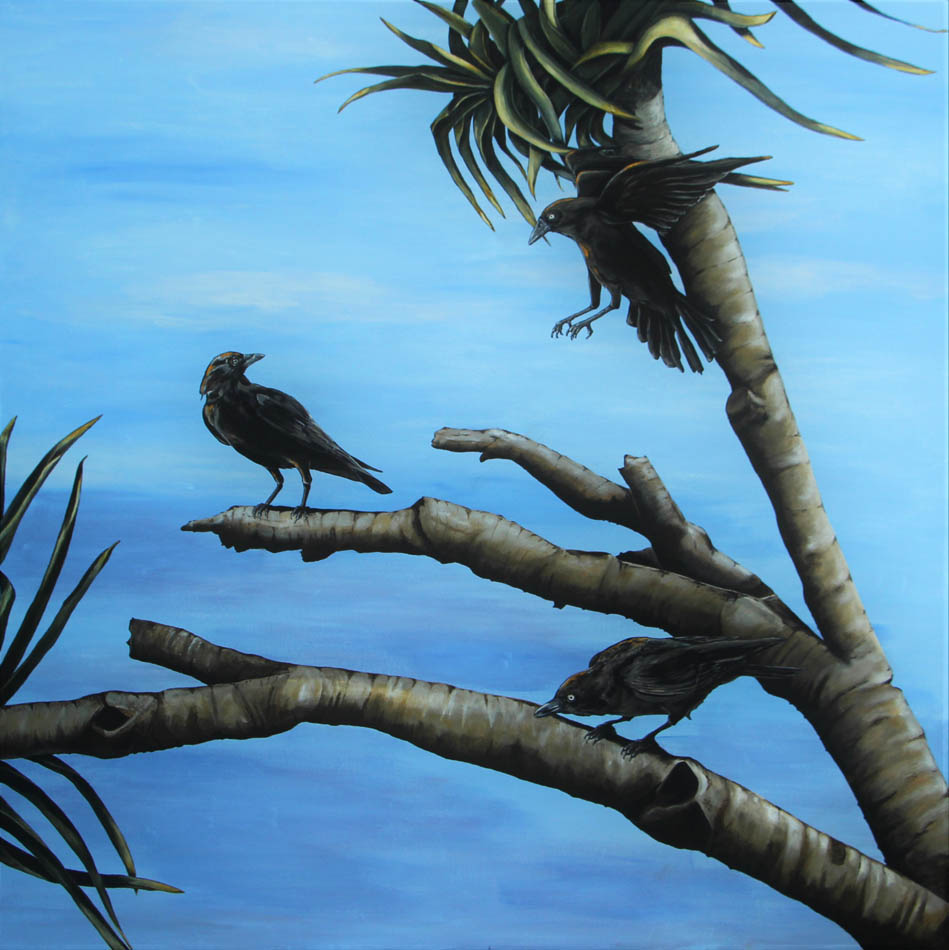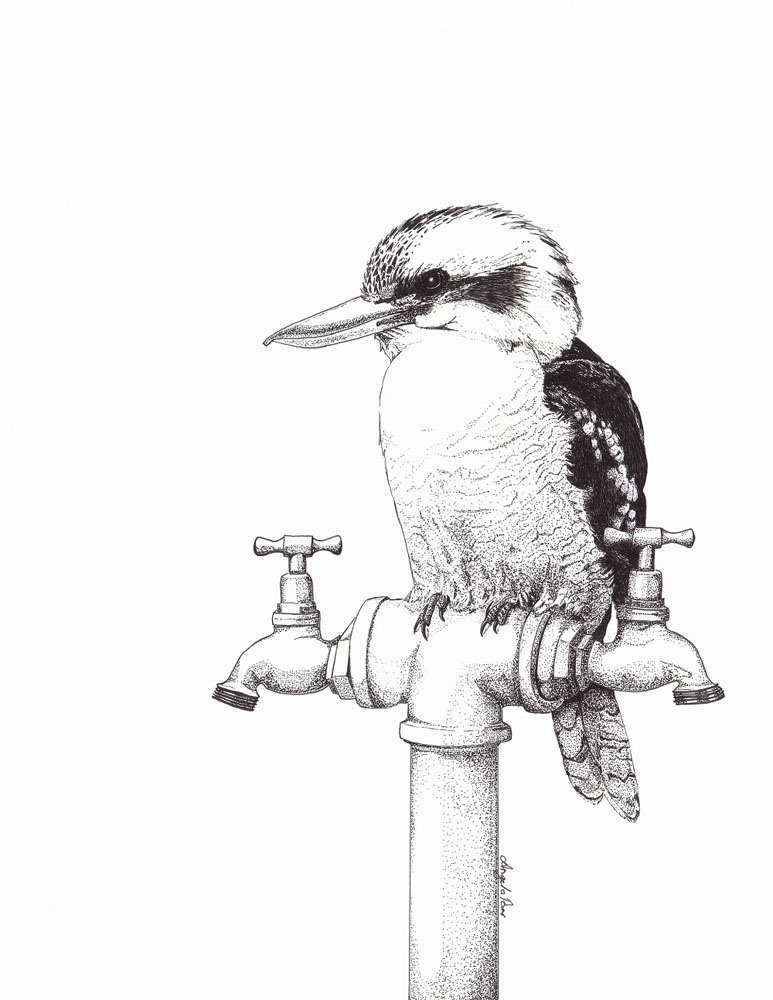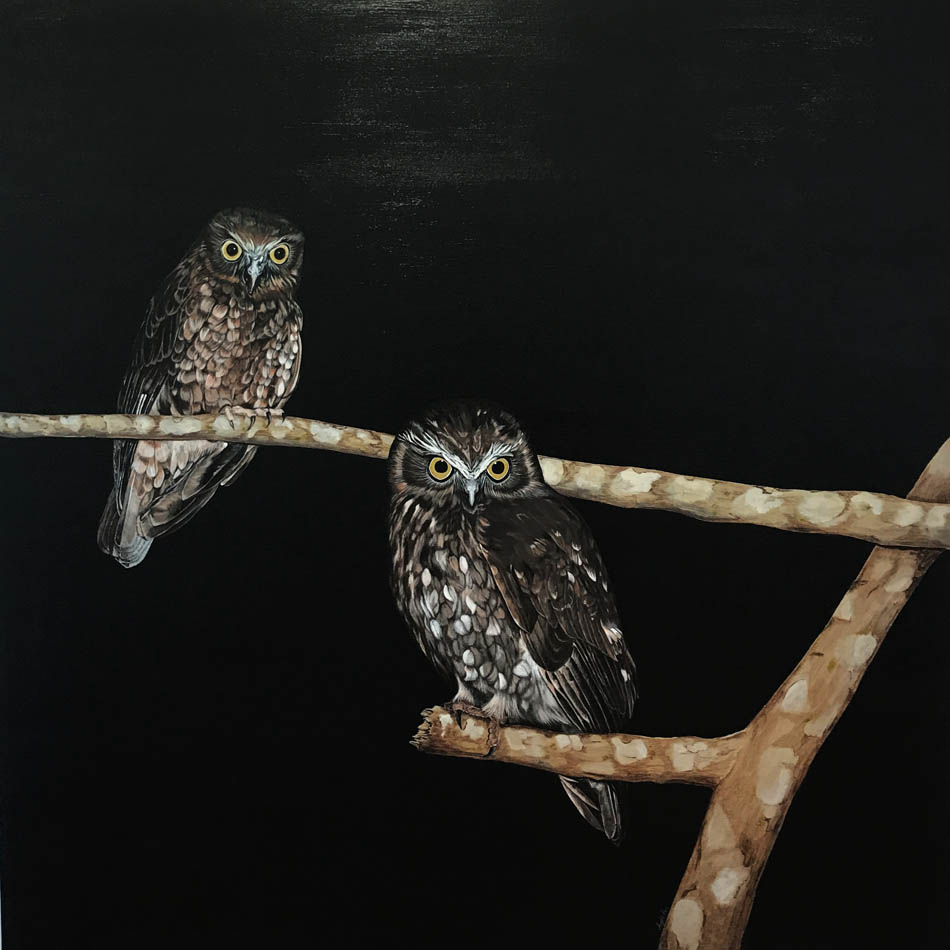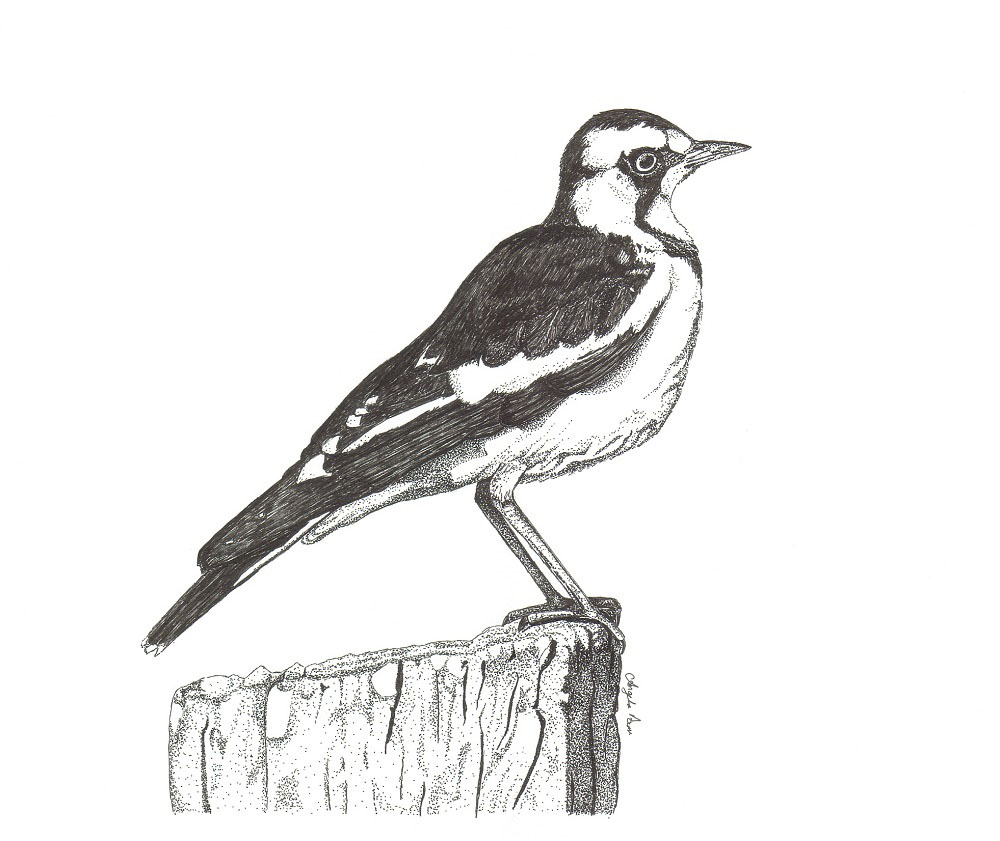Shop
-
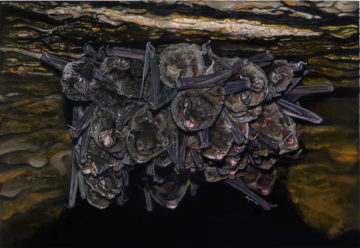
Little Bentwing Bats Roosting
Pastel on Canson paper (Sold)
63 cm W x 48 cm H
Little Bent-wing Bats (Miniopterus australis) roost in caves, mine tunnels and tree hollows, often in colonies numbering in the hundreds. Common Bent-wing Bats are often found roosting alongside them. Like all microbats, Little Bent-wing Bats also feed on small insects that fly beneath the canopy of thick forests. They are agile fliers, having to manoeuvre through the trees to catch their prey. Female Little Bent-wing Bats have a single baby in summer. They leave their babies in nursery caves at night to go and hunt, returning in the morning. These bats are also vulnerable to disturbance from human visitors to cave roosts, destruction of caves by limestone mining, and loss of feeding habitat by forestry operations, clearing and land degradation from agriculture.
I enjoyed creating this artwork although I found it challenging controlling the pastel dust fallout on the black paper and counting all those heads, making sure everything aligned correctly.Read moreLittle Bentwing Bats Roosting
Pastel on Canson paper (Sold)
63 cm W x 48 cm H
Little Bent-wing Bats (Miniopterus australis) roost in caves, mine tunnels and tree hollows, often in colonies numbering in the hundreds. Common Bent-wing Bats are often found roosting alongside them. Like all microbats, Little Bent-wing Bats also feed on small insects that fly beneath the canopy of thick forests. They are agile fliers, having to manoeuvre through the trees to catch their prey. Female Little Bent-wing Bats have a single baby in summer. They leave their babies in nursery caves at night to go and hunt, returning in the morning. These bats are also vulnerable to disturbance from human visitors to cave roosts, destruction of caves by limestone mining, and loss of feeding habitat by forestry operations, clearing and land degradation from agriculture.
I enjoyed creating this artwork although I found it challenging controlling the pastel dust fallout on the black paper and counting all those heads, making sure everything aligned correctly.Quick View -
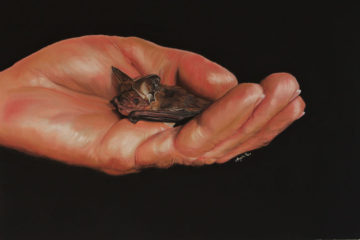
Long Eared Bat Being Held
Pastel on Canson paper ($POA)
63 cm W x 48 cm H
This was the final artwork of the “bat” series, (there were 8 in total), and this is probably my favourite as it clearly shows the diminutive size of microbats. Lesser Long-eared Bats (Nyctophilus geoffroyi) occur in towns and suburbs, roosting in hollows and fissures in old trees, under bark, in old fairy marten (bird) nests and occasionally in caves. They also often roost in ceilings, hollow walls, unused roller doors and canvas awnings in suburban and inner-city areas. Lesser Long-eared Bats hunt near the ground, and swoop around street lights at night catching insects. They are at risk from pesticides and cats. Luckily they prefer hollows of big old eucalypts for nursery colonies.Read moreLong Eared Bat Being Held
Pastel on Canson paper ($POA)
63 cm W x 48 cm H
This was the final artwork of the “bat” series, (there were 8 in total), and this is probably my favourite as it clearly shows the diminutive size of microbats. Lesser Long-eared Bats (Nyctophilus geoffroyi) occur in towns and suburbs, roosting in hollows and fissures in old trees, under bark, in old fairy marten (bird) nests and occasionally in caves. They also often roost in ceilings, hollow walls, unused roller doors and canvas awnings in suburban and inner-city areas. Lesser Long-eared Bats hunt near the ground, and swoop around street lights at night catching insects. They are at risk from pesticides and cats. Luckily they prefer hollows of big old eucalypts for nursery colonies.Quick View -
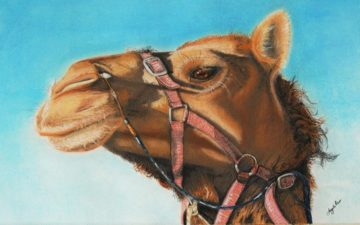
Dixie Doo
Pastel on Canson paper (Sold)
64 cm W x 47 cm H
In 2014 I had the good fortune to join a 3-month camel expedition through the deserts of the Northern Territory and South Australia, with my Red Heeler cattle dog Ruby. The experience was phenomenal, trekking over 20kms daily with eight adult camels, 5 chickens and eventually 5 baby camels…Yes, they were born along the way, but that’s another story. My favourite camel, the one I bonded best with was Dixie, and this artwork is a tribute to her. Between 1870 and 1920, as many as 20,000 camels were imported into Australia from the Arabian Peninsula, India and Afghanistan, together with at least 2,000 handlers, or cameleers, from the same regions. The animals were mainly dromedaries: half-ton ungulates with a single hump, (Camelus dromedarius). They were ideally suited to the harsh, dry climate of the Australian interior: they could go weeks without water, and they had the stamina and strength to carry their loads and riders across what were often highly exposed, fiercely hot landscapes. Laden camels carrying wool and water, telegraph poles and railway sleepers, tea and tobacco became a fixture of outback life. By the 1930s, however, with the arrival of the internal combustion engine, and motorised transport, camels became almost redundant as pack-carriers. A four-legged mammal was no match for a goods vehicle, regardless of how stoic it remained in 40C heat. Thousands of camels were released into the wild, where, naturally, they thrived.Read moreDixie Doo
Pastel on Canson paper (Sold)
64 cm W x 47 cm H
In 2014 I had the good fortune to join a 3-month camel expedition through the deserts of the Northern Territory and South Australia, with my Red Heeler cattle dog Ruby. The experience was phenomenal, trekking over 20kms daily with eight adult camels, 5 chickens and eventually 5 baby camels…Yes, they were born along the way, but that’s another story. My favourite camel, the one I bonded best with was Dixie, and this artwork is a tribute to her. Between 1870 and 1920, as many as 20,000 camels were imported into Australia from the Arabian Peninsula, India and Afghanistan, together with at least 2,000 handlers, or cameleers, from the same regions. The animals were mainly dromedaries: half-ton ungulates with a single hump, (Camelus dromedarius). They were ideally suited to the harsh, dry climate of the Australian interior: they could go weeks without water, and they had the stamina and strength to carry their loads and riders across what were often highly exposed, fiercely hot landscapes. Laden camels carrying wool and water, telegraph poles and railway sleepers, tea and tobacco became a fixture of outback life. By the 1930s, however, with the arrival of the internal combustion engine, and motorised transport, camels became almost redundant as pack-carriers. A four-legged mammal was no match for a goods vehicle, regardless of how stoic it remained in 40C heat. Thousands of camels were released into the wild, where, naturally, they thrived.Quick View -
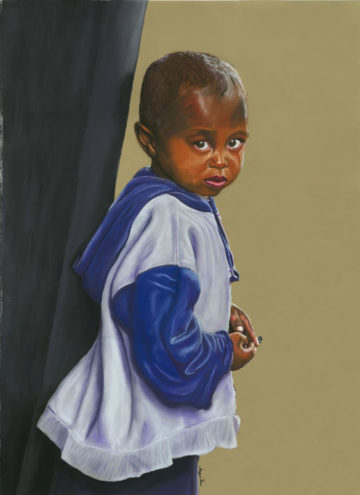
The Nail
Pastel on Mi Tientes Tex ($POA)
50 cm W x 70 cm H
I had spent a few weeks in Madagascar when I walked past this little boy standing outside his mother’s small, basic house in the outskirts of Antananarivo (the capital). He had the remnants of tears on his face, and I wonder what had upset him. It was only after I took the photo that I realised he held a nail in his hand as a “plaything”.Read moreThe Nail
Pastel on Mi Tientes Tex ($POA)
50 cm W x 70 cm H
I had spent a few weeks in Madagascar when I walked past this little boy standing outside his mother’s small, basic house in the outskirts of Antananarivo (the capital). He had the remnants of tears on his face, and I wonder what had upset him. It was only after I took the photo that I realised he held a nail in his hand as a “plaything”.Quick View -
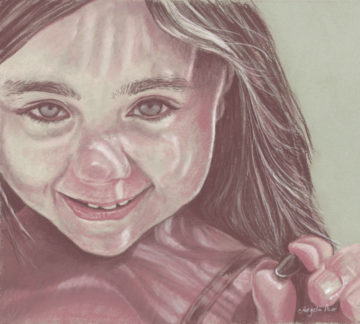
Beach Treasure
Pastel on Fabriano paper (NFS)
22 cm W x 20 cm H
This is one of our ten grandchildren with that happy summer look on her face. She is a real explorer and nature lover, always finding interesting things to show me.Read moreBeach Treasure
Pastel on Fabriano paper (NFS)
22 cm W x 20 cm H
This is one of our ten grandchildren with that happy summer look on her face. She is a real explorer and nature lover, always finding interesting things to show me.Quick View -
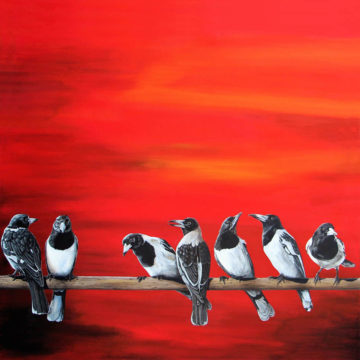
Butchers
Acrylic on canvas (Sold)
122 cm W x 122 cm H
The striking red background in this “Avian Criminal” piece hints strongly at the blood thirsty nature of the pied butcherbird (Cracticus nigrogularis) due to its habit of sometimes storing food items by impaling them on a stick or on barbed wire or shoving them in a nook or crevice. In ironic contrast the pied butcherbird has been considered the most accomplished songbird in Australia, its song described as a “magic flute”. Song melodies vary across the continent and no single song is sung by the whole population. There is no clear demarcation between simple calls and elaborate songs: duets, and even larger choirs, are common. The species improvises extensively in creating new and complex melodies. One of its calls has been likened to the opening bars of Beethoven’s Fifth Symphony. Singing often takes place at dawn, rarely late in the day, but sometimes on moonlit nights.Read moreButchers
Acrylic on canvas (Sold)
122 cm W x 122 cm H
The striking red background in this “Avian Criminal” piece hints strongly at the blood thirsty nature of the pied butcherbird (Cracticus nigrogularis) due to its habit of sometimes storing food items by impaling them on a stick or on barbed wire or shoving them in a nook or crevice. In ironic contrast the pied butcherbird has been considered the most accomplished songbird in Australia, its song described as a “magic flute”. Song melodies vary across the continent and no single song is sung by the whole population. There is no clear demarcation between simple calls and elaborate songs: duets, and even larger choirs, are common. The species improvises extensively in creating new and complex melodies. One of its calls has been likened to the opening bars of Beethoven’s Fifth Symphony. Singing often takes place at dawn, rarely late in the day, but sometimes on moonlit nights.Quick View -
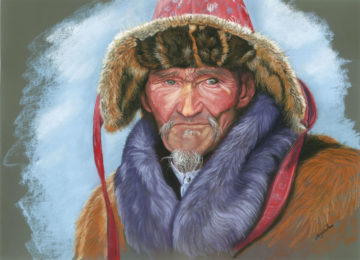
Mongolian Eagle Hunter
Pastel on Mi Tientes Tex paper ($POA)
89 cm W x 70 cm H
Several years ago, my husband and I had a great good fortune to be able to travel to Western Mongolia and attend the famed Golden Eagle Festival. What magnificent days we spent there, learning about, and being immersed in ancient Mongolian culture. This interesting face was one of the “judges” and his garb was typical of what all the other participants were wearing, thick fur hats and coats to keep out the cold.Read moreMongolian Eagle Hunter
Pastel on Mi Tientes Tex paper ($POA)
89 cm W x 70 cm H
Several years ago, my husband and I had a great good fortune to be able to travel to Western Mongolia and attend the famed Golden Eagle Festival. What magnificent days we spent there, learning about, and being immersed in ancient Mongolian culture. This interesting face was one of the “judges” and his garb was typical of what all the other participants were wearing, thick fur hats and coats to keep out the cold.Quick View -
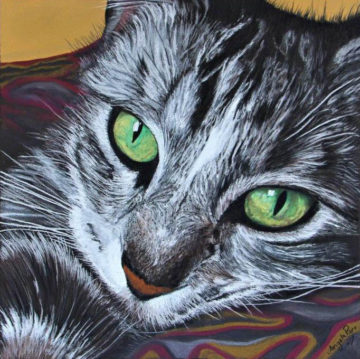
Casey
Pastel on Canson paper (Sold)
30 cm W x 30 cm H
The devastating flood of 2017 saw almost 20,000 people evacuated from the northern rivers area of NSW. The flood peaked at 11.59 metres in Lismore on March 31, overtopping the levee and inundating the CBD. It affected 68 per cent of businesses resulting in an estimated damage bill of just under $40 million. Afterwards when the water receded almost every home and business on the floodplain had a large muddy pile of possessions stacked on the roadside awaiting council pick-up. In some areas possessions had floated away and were now scattered across open areas. Pets were also lost with one family losing some sixty guinea pigs. As an artist I offered to “memorialise” some of these lost pets. Casey was one of these much-loved pets, and her owner was grateful to receive my tribute to her.Read moreCasey
Pastel on Canson paper (Sold)
30 cm W x 30 cm H
The devastating flood of 2017 saw almost 20,000 people evacuated from the northern rivers area of NSW. The flood peaked at 11.59 metres in Lismore on March 31, overtopping the levee and inundating the CBD. It affected 68 per cent of businesses resulting in an estimated damage bill of just under $40 million. Afterwards when the water receded almost every home and business on the floodplain had a large muddy pile of possessions stacked on the roadside awaiting council pick-up. In some areas possessions had floated away and were now scattered across open areas. Pets were also lost with one family losing some sixty guinea pigs. As an artist I offered to “memorialise” some of these lost pets. Casey was one of these much-loved pets, and her owner was grateful to receive my tribute to her.Quick View -
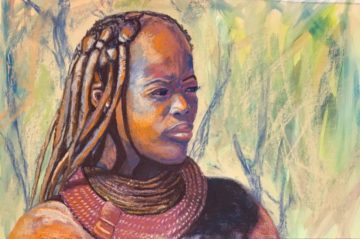
Himba Queen
Watercolour base and pastels on Mi Tientes Tex ($POA)
54 cm W x 73 cm H
Another wonderful trip overseas saw us in Namibia, Africa where we met and spent time with the Himba tribe. Himba people, especially women, are famous for covering themselves with otjize paste, a cosmetic mixture of butterfat and ochre pigment. Otjize cleanses the skin over long periods due to water scarcity and protects from the hot and dry climate of the Kaokoland, as well as from insect bites. It gives Himba people’s skin and hair plaits a distinctive texture, style, and orange or red tinge, and is often perfumed with the aromatic resin of the omuzumba shrub. Otjize is considered foremost a highly desirable aesthetic beauty cosmetic, symbolizing earth’s rich red color and blood, the essence of life, and is consistent with the OvaHimba ideal of beauty. Women who have been married for about a year or have had a child wear an ornate headpiece called the Erembe, sculptured from sheepskin, with many streams of braided hair coloured and put in shape with otjize pasteRead moreHimba Queen
Watercolour base and pastels on Mi Tientes Tex ($POA)
54 cm W x 73 cm H
Another wonderful trip overseas saw us in Namibia, Africa where we met and spent time with the Himba tribe. Himba people, especially women, are famous for covering themselves with otjize paste, a cosmetic mixture of butterfat and ochre pigment. Otjize cleanses the skin over long periods due to water scarcity and protects from the hot and dry climate of the Kaokoland, as well as from insect bites. It gives Himba people’s skin and hair plaits a distinctive texture, style, and orange or red tinge, and is often perfumed with the aromatic resin of the omuzumba shrub. Otjize is considered foremost a highly desirable aesthetic beauty cosmetic, symbolizing earth’s rich red color and blood, the essence of life, and is consistent with the OvaHimba ideal of beauty. Women who have been married for about a year or have had a child wear an ornate headpiece called the Erembe, sculptured from sheepskin, with many streams of braided hair coloured and put in shape with otjize pasteQuick View -
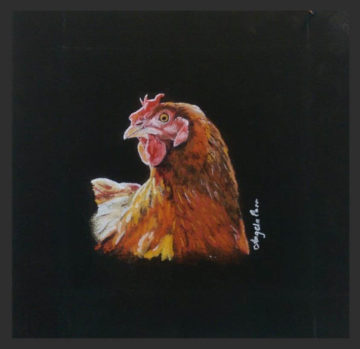
Chicken (Miniature)
Pastel on Canson paper (Sold)
15 cm W x 15 cm H
This small fun piece was done as a donation for a Cancer Council fundraiser.Read moreChicken (Miniature)
Pastel on Canson paper (Sold)
15 cm W x 15 cm H
This small fun piece was done as a donation for a Cancer Council fundraiser.Quick View -
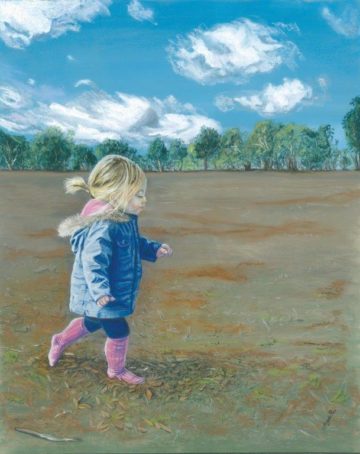
Pink Stocking’d Run
Pastel on Mi Tientes Tex (Sold)
67 cm W x 77 cm H
Another of our many grandchildren, this time a different season, winter, and she is enjoying a run in a leaf strewn park in her stocking’d feet. Ah the simple joys of childhood.Read morePink Stocking’d Run
Pastel on Mi Tientes Tex (Sold)
67 cm W x 77 cm H
Another of our many grandchildren, this time a different season, winter, and she is enjoying a run in a leaf strewn park in her stocking’d feet. Ah the simple joys of childhood.Quick View -
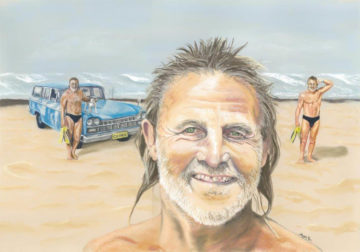
Gone to Atlantis (RIP Raz)
Pastel on Mi Tientes Tex (Sold)
86 cm W x 67 cm H
On February 16, 2019, Lyn ‘Raz’ Burtonwood was rostered for morning surf patrol at Lighthouse Beach, Ballina. He was a fit 69-year-old man who regularly attended the beach for his daily ocean swim. Raz jumped into the water to test the conditions, but quickly drifted down the beach. Soon other members of the surf patrol lost sight of him and immediately launched an inflatable rescue boat but could not locate him. Until light fell the search expanded to include jet skis, drones, helicopters and the SES and resumed again the following morning. The search was extensive, unfortunately, Raz was not found during the search and has not been seen since.
Raz was a well-loved schoolteacher and local identity of the area. He was affectionately known as “Salty Dog” due to his love of the ocean. His disappearance created much speculation, and it was widely “believed” he had been whisked away to the fabled undersea city of Atlantis.
I painted this montage of him, showing some of the many things he was famous for… His terrible self-created hairstyle, his crappy blue car, (which he never locked), his famous one armed “salute”, his small white dog that went everywhere with him, and of course his black speedos and yellow fins that accompanied him on his daily ocean swims. I’m very pleased to say that this portrait was purchased by a benefactor who kindly hung it in the Lighthouse Beach Café and Surf Club near Raz’s beloved beach.Read moreGone to Atlantis (RIP Raz)
Pastel on Mi Tientes Tex (Sold)
86 cm W x 67 cm H
On February 16, 2019, Lyn ‘Raz’ Burtonwood was rostered for morning surf patrol at Lighthouse Beach, Ballina. He was a fit 69-year-old man who regularly attended the beach for his daily ocean swim. Raz jumped into the water to test the conditions, but quickly drifted down the beach. Soon other members of the surf patrol lost sight of him and immediately launched an inflatable rescue boat but could not locate him. Until light fell the search expanded to include jet skis, drones, helicopters and the SES and resumed again the following morning. The search was extensive, unfortunately, Raz was not found during the search and has not been seen since.
Raz was a well-loved schoolteacher and local identity of the area. He was affectionately known as “Salty Dog” due to his love of the ocean. His disappearance created much speculation, and it was widely “believed” he had been whisked away to the fabled undersea city of Atlantis.
I painted this montage of him, showing some of the many things he was famous for… His terrible self-created hairstyle, his crappy blue car, (which he never locked), his famous one armed “salute”, his small white dog that went everywhere with him, and of course his black speedos and yellow fins that accompanied him on his daily ocean swims. I’m very pleased to say that this portrait was purchased by a benefactor who kindly hung it in the Lighthouse Beach Café and Surf Club near Raz’s beloved beach.Quick View -
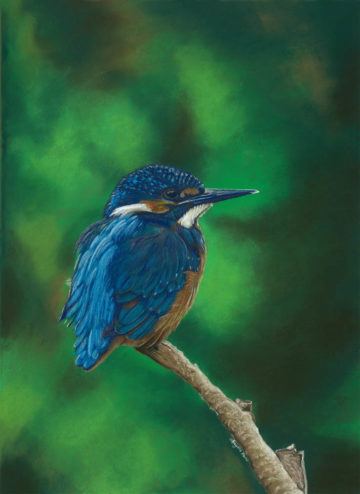
King of Fishers
Pastel on Canson paper (Sold)
50 cm W x 65 cm H
Australia has 10 native species of kingfishers, including the kookaburra, which is the largest. Kingfishers nest in tree hollows, in burrows in riverbanks and in termite nests. They feed on small animals, including fish, frogs, yabbies, snakes, insects and nestlings of other birds. Some kingfishers were once in danger of being hunted to extinction for their feathers. Despite their elaborate garb, these stocky birds are tough, and hunt by darting upon prey in a flash of colour from branches above the river or forest floor. The kingfisher’s heavy beak is the perfect tool for despatching victims quickly – they smack their hapless prey against tree branches before swallowing them whole. This small Azure Kingfisher (Alcedo azurea) is a tiny 17cm in length, with a wingspan of 25-29cm.Read moreKing of Fishers
Pastel on Canson paper (Sold)
50 cm W x 65 cm H
Australia has 10 native species of kingfishers, including the kookaburra, which is the largest. Kingfishers nest in tree hollows, in burrows in riverbanks and in termite nests. They feed on small animals, including fish, frogs, yabbies, snakes, insects and nestlings of other birds. Some kingfishers were once in danger of being hunted to extinction for their feathers. Despite their elaborate garb, these stocky birds are tough, and hunt by darting upon prey in a flash of colour from branches above the river or forest floor. The kingfisher’s heavy beak is the perfect tool for despatching victims quickly – they smack their hapless prey against tree branches before swallowing them whole. This small Azure Kingfisher (Alcedo azurea) is a tiny 17cm in length, with a wingspan of 25-29cm.Quick View -
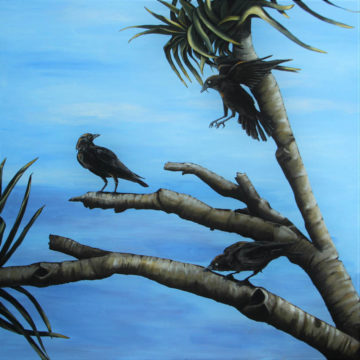
Murder
Acrylic on canvas (Sold)
122 cm W x 122 cm H
‘Murder’ was the first in my Avian series, based upon a scene that played out before me as I walked around a headland of my local beach. Torresian Crows (Corvus orru) were rising from and descending back to the Pandanus tree growing on the edge of the cliff, as the stiff wind aided their activity. The sky was gloomy and dark with an impending storm, and I thought to myself, there is a painting here begging to be actualised.Read moreMurder
Acrylic on canvas (Sold)
122 cm W x 122 cm H
‘Murder’ was the first in my Avian series, based upon a scene that played out before me as I walked around a headland of my local beach. Torresian Crows (Corvus orru) were rising from and descending back to the Pandanus tree growing on the edge of the cliff, as the stiff wind aided their activity. The sky was gloomy and dark with an impending storm, and I thought to myself, there is a painting here begging to be actualised.Quick View -
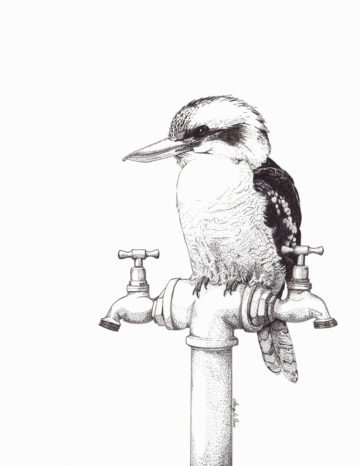
On the Watch
Ink on Arches paper (Sold)
48 cm W x 68 cm H
Kookaburras (Dacelo novaeguineae) are terrestrial tree kingfishers found in habitats ranging from humid forest to arid savannah, as well as in suburban areas with tall trees or near running water. Kookaburras are almost exclusively carnivorous, eating mice, snakes, insects, small reptiles, and the young of other birds; unlike many other kingfishers, they rarely eat fish, although they have been known to take goldfish from garden ponds. They often accept handouts and take meat from barbecues, but feeding kookaburras ground beef or pet food is not advised, as these do not include enough calcium and roughage for their health requirements.Read moreOn the Watch
Ink on Arches paper (Sold)
48 cm W x 68 cm H
Kookaburras (Dacelo novaeguineae) are terrestrial tree kingfishers found in habitats ranging from humid forest to arid savannah, as well as in suburban areas with tall trees or near running water. Kookaburras are almost exclusively carnivorous, eating mice, snakes, insects, small reptiles, and the young of other birds; unlike many other kingfishers, they rarely eat fish, although they have been known to take goldfish from garden ponds. They often accept handouts and take meat from barbecues, but feeding kookaburras ground beef or pet food is not advised, as these do not include enough calcium and roughage for their health requirements.Quick View -
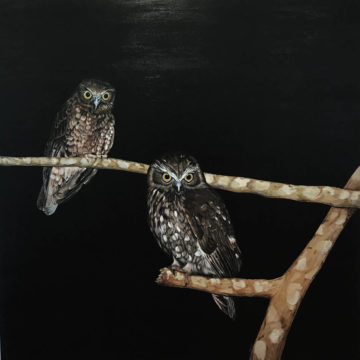
Parliament Sits in Judgement
Acrylic on canvas (Sold)
122 cm W x 122 cm H
Yet another in the ‘Avian’ series, these Australian Boobook Owls (Ninox boobook), derived their name from their two-tone boo-book call. In some regions known as the mopoke, they are the smallest owl native to the Australian mainland. Using a fence, branch, or telegraph pole as a perch or vantage point from which to hunt, the Australian boobook pounces on prey then retreats to a tree or elevated place to eat it. It often hunts in open areas near trees, and also where prey is likely to congregate, such as mice near haystacks or barns, or flying insects near street- or house-lights.Read moreParliament Sits in Judgement
Acrylic on canvas (Sold)
122 cm W x 122 cm H
Yet another in the ‘Avian’ series, these Australian Boobook Owls (Ninox boobook), derived their name from their two-tone boo-book call. In some regions known as the mopoke, they are the smallest owl native to the Australian mainland. Using a fence, branch, or telegraph pole as a perch or vantage point from which to hunt, the Australian boobook pounces on prey then retreats to a tree or elevated place to eat it. It often hunts in open areas near trees, and also where prey is likely to congregate, such as mice near haystacks or barns, or flying insects near street- or house-lights.Quick View -
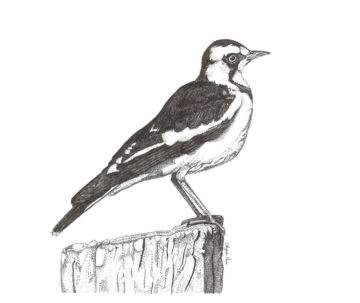
Pee Wee
Ink on Arches paper ($POA)
30 cm W x 23 cm H
When I used to do wildlife care, I often cared for orphaned and abandoned fledglings. Pee Wee was one of my success stories, being raised on mealworms, bugs and any other creepy crawlies I could procure for her. After she was old enough and took to the skies to go live independently, she would often return if I called out “Pee Wee” loudly enough for her to hear. This continued for several weeks before finally she never returned, presumably having made her own way into the world. Pee Wee was actually a magpie-lark, (Grallina cyanoleuca) often also known as the peewee, peewit or mudlark. The sexes are similar from a distance but easy to tell apart: the female has a white throat, the male a black throat and a white “eyebrow”.Read morePee Wee
Ink on Arches paper ($POA)
30 cm W x 23 cm H
When I used to do wildlife care, I often cared for orphaned and abandoned fledglings. Pee Wee was one of my success stories, being raised on mealworms, bugs and any other creepy crawlies I could procure for her. After she was old enough and took to the skies to go live independently, she would often return if I called out “Pee Wee” loudly enough for her to hear. This continued for several weeks before finally she never returned, presumably having made her own way into the world. Pee Wee was actually a magpie-lark, (Grallina cyanoleuca) often also known as the peewee, peewit or mudlark. The sexes are similar from a distance but easy to tell apart: the female has a white throat, the male a black throat and a white “eyebrow”.Quick View -
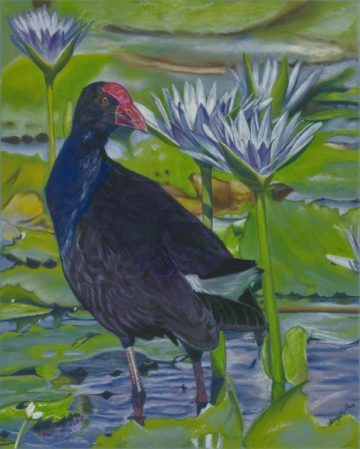
Pukeko
Pastel on Canson paper ($POA)
30 cm W x 36 cm H
Our dog was a very well behaved cattle dog who as a rule didn’t chase wildlife or birds, but there was something about the “pukeko” which drove her crazy. The Australasian swamphen (Porphyrio melanotus) is a species of swamphen occurring in eastern Indonesia, Papua New Guinea, Australia and New Zealand where it is known as the pukeko. They are a handsome bird of the wetlands, Conspicuous blue and black in colour with a gigantic red bill and forehead shield. They have large feet and white under tail feathers which they flick up and down when walking. They are very vocal, often making loud crowing calls and a range of other shorter squawks, including a single note squawk at night.Read morePukeko
Pastel on Canson paper ($POA)
30 cm W x 36 cm H
Our dog was a very well behaved cattle dog who as a rule didn’t chase wildlife or birds, but there was something about the “pukeko” which drove her crazy. The Australasian swamphen (Porphyrio melanotus) is a species of swamphen occurring in eastern Indonesia, Papua New Guinea, Australia and New Zealand where it is known as the pukeko. They are a handsome bird of the wetlands, Conspicuous blue and black in colour with a gigantic red bill and forehead shield. They have large feet and white under tail feathers which they flick up and down when walking. They are very vocal, often making loud crowing calls and a range of other shorter squawks, including a single note squawk at night.Quick View

